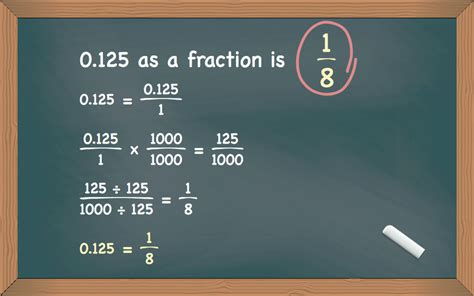What Is 0.125 As A Fraction
Kalali
Apr 01, 2025 · 4 min read

Table of Contents
What is 0.125 as a Fraction? A Comprehensive Guide
Understanding decimal-to-fraction conversion is a fundamental skill in mathematics. This comprehensive guide will explore how to convert the decimal 0.125 into its fractional equivalent, explaining the process in detail and providing additional examples to solidify your understanding. We'll delve into the underlying principles and offer various approaches, making this concept accessible to everyone, from beginners to those looking to refresh their knowledge.
Understanding Decimals and Fractions
Before we tackle the conversion of 0.125, let's briefly review the basics of decimals and fractions.
Decimals: Decimals represent numbers less than one using a base-ten system. The digits to the right of the decimal point represent tenths, hundredths, thousandths, and so on. For example, 0.1 represents one-tenth (1/10), 0.01 represents one-hundredth (1/100), and 0.001 represents one-thousandth (1/1000).
Fractions: Fractions represent parts of a whole. They are expressed as a ratio of two numbers, the numerator (top number) and the denominator (bottom number). The denominator indicates the total number of equal parts, while the numerator indicates how many of those parts are being considered. For example, 1/2 represents one out of two equal parts, and 3/4 represents three out of four equal parts.
Converting 0.125 to a Fraction: The Step-by-Step Process
The key to converting a decimal to a fraction lies in understanding the place value of the decimal digits. In 0.125, the digit 5 is in the thousandths place. This means 0.125 represents 125 thousandths. We can express this as a fraction:
125/1000
Now, we need to simplify this fraction to its lowest terms. This means finding the greatest common divisor (GCD) of the numerator (125) and the denominator (1000) and dividing both by it.
Finding the GCD:
Several methods exist to find the GCD. One common approach is to list the factors of both numbers and find the largest factor they share. Another is to use the Euclidean algorithm, which is particularly efficient for larger numbers.
For 125 and 1000, we can observe that 125 is a factor of 1000 (1000 = 125 x 8). Therefore, the GCD is 125.
Simplifying the Fraction:
Dividing both the numerator and the denominator by 125, we get:
(125 ÷ 125) / (1000 ÷ 125) = 1/8
Therefore, 0.125 as a fraction is 1/8.
Alternative Methods for Conversion
While the above method is straightforward, other approaches can be used to convert decimals to fractions.
Method 1: Using the Place Value Directly
As mentioned earlier, the decimal 0.125 represents 125 thousandths. We can write this directly as 125/1000 and then simplify as shown above. This method is efficient for decimals with a limited number of digits after the decimal point.
Method 2: Expressing as a Power of 10
We can express the decimal as a fraction with a power of 10 as the denominator. 0.125 can be written as:
125/1000
This is equivalent to 125/(10^3). Then simplify the fraction as shown in the primary method.
Practical Applications and Further Examples
Converting decimals to fractions is a crucial skill in various fields, including:
- Cooking and Baking: Recipes often require fractional measurements.
- Engineering and Construction: Precise measurements are essential, and fractions are often used.
- Finance: Calculations involving percentages and interest rates often involve fractions.
- Science: Many scientific calculations and measurements utilize fractions.
Let's examine a few more examples to reinforce the concept:
Example 1: Converting 0.25 to a fraction
0.25 represents 25 hundredths, which can be written as 25/100. Simplifying by dividing both numerator and denominator by 25, we get 1/4.
Example 2: Converting 0.6 to a fraction
0.6 represents 6 tenths, which can be written as 6/10. Simplifying by dividing both numerator and denominator by 2, we get 3/5.
Example 3: Converting 0.375 to a fraction
0.375 represents 375 thousandths, which can be written as 375/1000. The GCD of 375 and 1000 is 125. Dividing both by 125, we get 3/8.
Example 4: Converting 0.1 to a fraction
0.1 represents 1 tenth, which can be written as 1/10. This fraction is already in its simplest form.
Example 5: Converting 0.875 to a fraction
0.875 represents 875 thousandths, which can be written as 875/1000. The GCD of 875 and 1000 is 125. Dividing both by 125, we get 7/8.
Handling Repeating Decimals
Converting repeating decimals to fractions requires a slightly different approach. This will be covered in a future advanced guide. For now, we've focused on terminating decimals like 0.125.
Conclusion
Converting decimals like 0.125 to fractions involves understanding place value and simplifying the resulting fraction to its lowest terms. By mastering this skill, you'll enhance your mathematical proficiency and broaden your ability to work with numbers in various contexts. Remember the steps: identify the place value, write it as a fraction, and then simplify. With practice, you'll become proficient in converting decimals to fractions with ease. This fundamental skill forms the basis for more advanced mathematical concepts and is invaluable across numerous applications.
Latest Posts
Latest Posts
-
How Many Glasses Is 32 Oz Of Water
Apr 02, 2025
-
How Many Inches Is 183 Cm
Apr 02, 2025
-
What Is The Difference Between Basic Science And Applied Science
Apr 02, 2025
-
182 Inches Is How Many Feet
Apr 02, 2025
-
What Role Do Producers Play In The Ecosystem
Apr 02, 2025
Related Post
Thank you for visiting our website which covers about What Is 0.125 As A Fraction . We hope the information provided has been useful to you. Feel free to contact us if you have any questions or need further assistance. See you next time and don't miss to bookmark.
